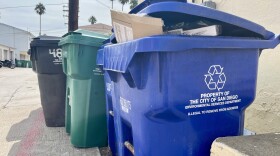The $3 million San Diego County allocated to open a welcome center for asylum-seekers and other migrants is expected to run out by the middle of December, San Diego County Supervisor Nora Vargas told reporters on Friday.
That money was meant to last three months, according to a staff report. But, Vargas said, the center costs $1.5 million a month to operate. Without additional funding, migrants will go back to being dropped off at various transit centers throughout the region, she said.
“The last thing we want is for folks not to have a place where they can be safe in our community,” she said.
SBCS, formerly known as South Bay Community Services, was awarded the $3 million to operate the welcome center. The nonprofit asked KPBS not to identify the center’s location out of concerns that people might harass the migrants.
Each day, the center receives 500 to 700 people from around the world. All of them are released from Customs and Border Protection custody. Most of them don’t plan to stay in San Diego because they have friends or relatives in other parts of the United States, according to SBCS staff.
Migrants at the center have access to a wide range of services: phone chargers so they can talk to relatives and make travel arrangements, transportation to the airport or bus terminals, temporary housing, and food.
The kitchen makes 600 meals each day. For some visitors, it is the first hot meal they’ve had in days.
Other nonprofits, including Haitian Bridge Alliance, Al Otro Lado and Immigrant Defenders Law Center, provide legal aid and translation services at the center. But they do so at their own expense. Those organizations did not receive money from the county for this project.
Vargas said the federal government’s lack of leadership on this issue meant that local governments have had to step up.
“If it wasn’t for the fact that the County of San Diego was able to allocate those $3 million, we would have been in a very difficult situation,” she said.
U.S. Rep. Juan Vargas, a Democratic congressman whose district includes the South Bay, pointed out that the $3 million is federal money — it comes from the American Rescue Plan, a 2021 pandemic stimulus package. Still, he acknowledged that the federal government needs to do more.
“We’ve spent a lot of money on this issue, but not enough,” said Rep. Vargas, who is not related to Nora Vargas.
Rep. Vargas said he would continue to push for comprehensive immigration reform in Congress, which he considers crucial to the nation's long-term prosperity.
“It’s a blessing to get people that are young and want to work,” he said. “I mean, our labor participation rate in this country has dropped dramatically. Unless we have more children or unless more immigrants come here, our economy in the long term is going to suffer dramatically.”

Rep. Vargas said he was not optimistic for the prospects of comprehensive immigration reform. “I have all the confidence that nothing is going to happen, sadly,” he said.
At the welcome center, there is some minor confusion about the specific cost breakdown of the $3 million, which was supposed to last for three months.
A San Diego County spokesperson told The San Diego Union-Tribune that most of the funds are being spent on transportation costs. However, SBCS staff told KPBS that approximately 15% of the money is being spent on transportation.
Other expenses include staffing, insurance, supplies, food, temporary housing, and funding for partner organizations such as Casa Familiar and Logan Heights CDC.
“There’s a lot that goes into the operations of a site this large,” said Mauricio Torre, of SBCS.
Supervisor Vargas said she was confident that SBCS could continue to run the program.
“They’ve gone above and beyond to be our partners,” she said. ”I think this should be the model for the United States.”







